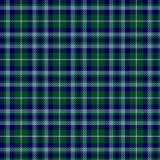Tartan of the Royal Corps of Signals

When one thinks of Scotland, many iconic images come to mind; rolling green hills, ancient castles, and Nessie swimming in her loch. Even more memorable than these, however, is the patterned fabric which has come to symbolize Scottish culture itself: Tartan is the only textile design in the world of which a tiny scrap can evoke such feelings of pride, such identification with the historical struggles of Scots, and identification with those desirable traits associated with being Scottish - honesty, industriousness and bravery in battle.*
Although tartan-style fabrics have a very long history – a good portion of it not Scottish – today these textiles are most famous as badges of identification. Specific colors and their arrangements function as a symbolic language in their own right, representing individuals, families and clans, as well as professional groups, companies, and organizations. To the huge international family of Scots and their descendants - estimated at 40 to 60 million around the globe - tartan represents everything that is admirable and wholesome about the land of their fathers.*
This tartan celebrates all past, present, and future personnel and achievements attached to the Royal Corps of Signals. This corps was formed in 1920, and by the end of World War II its members had served in every theatre of war. This tartan encompasses the significant colours associated with the Royal Corps of Signals: light blue, blue and green. White represents the ‘silvery white’ of the Roman God 'Mercury', as featured on the Royal Corps of Signals insignia and cap badge. Along with their motto; “Certa Cito”, meaning ‘Swift and Sure’.**
*http://www.tartansauthority.com/tartan/
**https://www.tartanregister.gov.uk/tartanDetails?ref=12137
© Symbols.com
